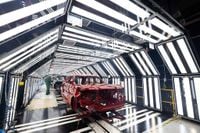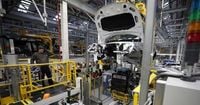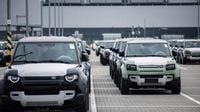Britain’s automotive industry, a pillar of its manufacturing sector, has been dealt a bruising blow after an unprecedented cyberattack on Jaguar Land Rover (JLR) led to the sharpest monthly production drop in decades. The five-week shutdown of JLR’s factories, which began at the start of September 2025, triggered a cascade of consequences that rippled far beyond the company’s own assembly lines, slashing total UK car output by 27% for the month—down to just over 51,000 vehicles, according to the Society of Motor Manufacturers and Traders (SMMT).
To put it plainly, September 2025 saw the lowest number of cars built in the UK for that month since 1952. That’s not just a blip—it’s a throwback to the days of rationing and the British Motor Corporation’s dominance, as noted by The Guardian. Even the pandemic years didn’t see such a dramatic fall, underscoring the scale of the disruption. JLR, owned by Tata Motors, is the country’s largest automotive employer and typically produces about 1,000 cars a day across its three UK factories. But in September, its output was zero.
The immediate cause? A cyberattack classified as a category three systemic event, the most economically damaging of its kind in British history. The Cyber Monitoring Centre (CMC), a non-profit tracking major cyber incidents, estimated the cost to the UK economy at a staggering £1.9 billion. According to Reuters, the attack affected more than 5,000 organizations—suppliers, logistics firms, and partners—across the country, with the impact expected to linger until at least January 2026.
JLR’s IT systems were forced offline, halting global manufacturing operations and leaving its UK plants in Solihull, Wolverhampton, and Halewood idle. Recovery has been slow and cautious, with production only resuming in phases this October. As one manufacturing executive told The Guardian, “the ramp-up has gone better than expected,” thanks in part to advance planning with key suppliers, but the road back to full normality is long.
While JLR’s woes dominated the headlines, the broader industry was already grappling with a “low-volume crisis.” Increased competition from China, the costly transition to electric vehicles, and persistent inflation and high interest rates had all been squeezing margins and dampening consumer demand. The cyberattack, then, was a knock-out punch just as the industry was trying to get back on its feet.
“September’s performance comes as no surprise given the total loss of production at Britain’s biggest automotive employer following a cyber incident,” said SMMT chief executive Mike Hawes, as reported by BBC. He added, “While the situation has improved, the sector remains under immense pressure.”
The numbers are stark. UK car production for the domestic market fell 34.1% in September to just 12,269 vehicles. Exports, which account for three-quarters of all output, dropped 24.5%, with the EU, US, Turkey, Japan, and South Korea remaining the top destinations. Commercial vehicle production fared even worse, plunging 77.9% to 3,229 units in September, largely due to Stellantis consolidating operations and shuttering its Vauxhall van plant in Luton earlier this year. Combined car and van production tumbled 35.9% to 54,319 vehicles, as City A.M. highlighted.
So far in 2025, UK car and van factories have produced 582,250 vehicles, down 15.2% from the same period in 2024. The SMMT noted that almost half (47.8%) of cars made in September were battery electric, plug-in hybrid, or hybrid models, a 14.7% increase in volume, but this wasn’t enough to offset the overall slump.
The economic pain isn’t limited to production figures. The CMC’s research found that the cyberattack’s fallout hit around 5,000 businesses, from parts suppliers to logistics firms, forcing many to pause or slow operations as JLR’s assembly lines ground to a halt. The ripple effects are expected to last for months, with full recovery not anticipated until January 2026.
JLR’s own sales figures have taken a hit as well. In the second quarter of its financial year, wholesales fell 24.2% to 66,165 units compared to the same period last year, while retail sales declined 17.1% to 85,495 units. The company cited not only the cyberattack but also the planned wind-down of legacy Jaguar models and incremental US tariffs as factors. “It has been a challenging quarter for JLR,” admitted chief executive Adrian Mardell. “In the first two months our performance was robust and in line with our expectations, against the backdrop of the planned wind down of legacy Jaguar models and the impact of incremental US tariffs.”
As the sector looks ahead, there are mounting fears that government policy could deepen the crisis. The UK government’s ambition, set out in June’s Industrial Strategy, is to restore domestic car production to 1.3 million vehicles a year. But that goal is now in jeopardy, industry leaders warn, if Chancellor Rachel Reeves proceeds with plans to end tax breaks for Employee Car Ownership Schemes (ECOS).
These schemes allow automotive workers to buy the cars they help make at preferential rates, a key part of remuneration in the sector. According to the SMMT, reclassifying ECOS vehicles to make them liable for company car tax would put them “out of reach for most automotive workers.” The impact could be severe: 60,000 manufacturing workers affected, 80,000 fewer new car sales per year, and a reduction in UK production volumes by up to 20,000 cars. The SMMT estimates this would mean a revenue loss of more than £1 billion, 5,000 jobs at risk, and a near £500 million hit to government finances from lost VAT and Vehicle Excise Duty receipts.
“The move to scrap ECOS immediately puts that ambition in doubt and must be reversed given the damage it will inflict on the sector and exchequer revenues,” said Mike Hawes, echoing a chorus of industry voices urging the government to reconsider ahead of the November 26 Budget.
Despite the grim numbers, there are glimmers of hope. Ian Plummer, boss of the UK’s biggest car-selling platform Autotrader, told BBC that demand for JLR brands remains strong, even if the supply pipeline is currently blocked. “It’ll be a bit like Covid, where after the shutdown and delays end, there’s a surge in demand and sales,” he predicted. But for now, the sector’s recovery hinges on both technological resilience and supportive government policy.
As the dust settles from the most expensive cyberattack in British history, the message from Britain’s carmakers is clear: the industry is battered, but not beaten. With the right support, they believe a comeback is possible—but the road ahead will require more than just patching up old systems. It’ll take vision, investment, and, crucially, a little bit of luck.






